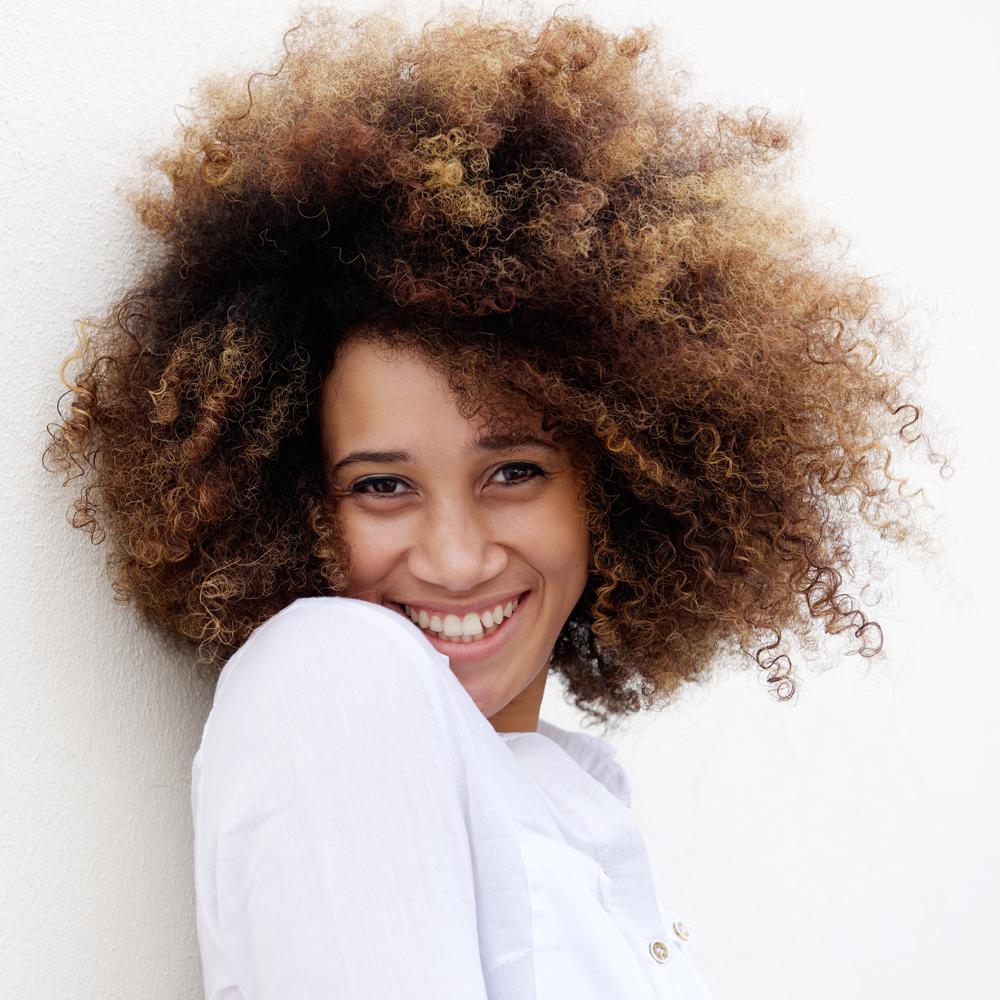
The Dirt on Chemical Straighteners and Treatments
Almost everyone with curly or coily hair has wished their hair was straight at one point in their life. Whether it was on a bad hair day that you had an important meeting or event, or on wash day when your arms start to tire from holding them up for hours.
Having textured hair is a constant inward tug-of-war battle. You love the volume and versatility of your hair, but you hate the hours it takes to do it.
You’ve probably even gone through, or are going through a phase of constantly blow-drying and straightening your hair. It’s less work with straight hair right? After a visit to the salon, all you have to do is run a flat iron through your hair a few times every other morning and you’re all set.
On the flip side, having temporarily straightened hair can be another battle. Say “see ya later” to the gym, because you don’t want to sweat your edges out. You have to avoid going near any body of water that could potentially get your hair wet.
Having textured hair can feel like a lose-lose situation when you may not have the time or patience to maintain your hair. With this feeling of defeat comes thoughts of ways to permanently straighten your hair.

Permanent hair straightening treatments are a form of chemical processing for your hair. Depending on what method of processing you use, hair that’s naturally curly or textured can be altered to lay flat and lose its curl.
Chemically processing your hair will have long-term and potentially damaging effects. Because of this, many women have chosen to stop processing their hair or have never even attempted to. If you choose to relax your hair, it is important to be as educated as possible on the topic before you make that decision.
There are a multitude of chemical products known as relaxers or keratin treatments that women with type 3, and especially type 4 hair, have been known to use.
These treatments work for several months or more, usually lasting until new hair grows in to replace the hair that was treated. It can be argued that it’s technically not a permanent process because once your hair grows in, you have to retouch the new growth to match the processed hair.
On the other hand, once you treat your hair with this type of chemical product, it has permanent, damaging effects on your hair. The only way to get your natural hair texture back is to cut off the hair that was affected by the treatment.
TYPES OF STRAIGHTENING TREATMENTS
There are several types of straightening treatments that claim to make your hair straighter. Each type is composed of different chemical formulas and processing methods.
Some of these treatments are sold in kits that you can do yourself at home, while others require salon-grade equipment to be done effectively.
Relaxer

A relaxer will stretch the natural curl pattern or tightly curled hair depending on the strength and the timing of the chemical. The relaxer is a creamy paste that gets applied directly on to the hair avoiding the scalp.
The scalp is avoided because relaxers are composed of chemicals that can burn the scalp if left on for too long, leaving you with open wounds that can eventually scab over.
Relaxer application is quickly followed by cleansing the hair and scalp with a neutralizing shampoo. This is the most important step!
A neutralizing shampoo is necessary to help restore hair's natural pH to prevent damage. Most neutralizing shampoos has a color indicating lather that helps ensure all residue is removed.
The main active ingredient in relaxers is Sodium Hydroxide. Sodium Hydroxide relaxers are very effective in breaking down the hair's bonds and straightening the hair quickly. Because it processes quickly it is also the most commonly used relaxers by professionals. The level of hydroxide used in relaxers determines the strength.
Relaxers can be marketed as base and no-base relaxers. Base relaxers require stylists to base the client’s entire scalp with a protective cream prior to the chemical relaxer application. Whereas no-base relaxers have a protective cream built within the relaxer that settles onto the scalp according to the client’s body temperature.
Although no-base relaxers have a thin oil-like protective cream within the relaxer system, most stylists use a base cream around the ears and hairline for added protection.
The chemical components of relaxer can make it dangerous to apply at home.
Getting a relaxer in the salon vs doing it at home will affect your pockets differently. Salon relaxers can be upwards of $60. At home treatments can be purchased in the beauty supply store for around $15.
Although the price difference is pretty big, it’s less dangerous to get your hair relaxed by a salon professional, should you choose to relax your hair.
Keratin Hair Treatments
Keratin hair treatments, also known as Brazilian blowouts, are a semi-permanent hair straightening treatment which involves treating your hair for a straight texture that lasts 3 to 5 months.
This method can take multiple salon appointments to finish application, and typically costs over $150. This hair smoothing method is done by temporarily sealing a liquid keratin and a preservative solution into the hair with a hair iron. Keratin treatments are done on a range of hair types, from wavy to coily hair.
Depending on the treatment used, if you get a Brazilian blowout, you may have to avoid washing, wetting, pinning or constraining your hair in any way for some period after application, which can be up to three days. Results can last up to six months.
The difference between a relaxer and keratin treatment is that keratin treatments are not permanent. They typically are wash out after a few months. The two treatments also use different ingredients that produce different results.
Some treatments may contain a solution that releases formaldehyde when exposed to heat, but there are many that are formaldehyde-free. Formaldehyde is a carcinogen, and although the amount of formaldehyde released in a keratin treatment is not grand, you should still avoid it. Formaldehyde-free treatments are not as effective and long-lasting as the formaldehyde formulas, but they are much safer.
Instead of altering the chemical composition of your hair, like a relaxer, keratin treatments inject the porous parts of your hair with protein, so that it feels smoother.
Although there are some at-home keratin treatment options, it is definitely suggested to go to a salon. Where a salon treatment can last for several months, at-home versions tend to wash out after a few weeks.
SIDE EFFECTS OF CHEMICAL STRAIGHTENERS
Before you decide to chemically process your hair, it is important to understand the potential side effects.
Hair breakage after a permanent hair straightening treatment is very common. The chemical solution works by damaging your hair so it lies flat or releases its natural curl.
Relaxers, when not applied correctly or left on for too long, can burn the scalp and even break off your hair. Avoid scratching or combing your hair before a relaxer application. This can make your scalp more susceptible to burns and scabs.
The best way to return your hair to its natural curl pattern after a relaxer is to cut the chemically processed ends, or let your new growth grow in and frequently trim your ends, until all of the processed hair is gone.
Since keratin treatments aren’t permanent, you will most likely not see long-term effects to your hair. However, the density and strength of your hair follicles will determine how much heat and processing your hair can withstand.
According to the Environmental Working Group, chemical straighteners that are lye-free or alkaline sulfite-based are safer than some alternatives. Of course, the safest option of all is to avoid exposure to harmful chemicals that can absorb through your scalp and your nasal passages.
You shouldn’t get any of these permanent straightening treatments if you’re pregnant or trying to become pregnant.
PROS AND CONS
The pros and cons of each hair straightening depend on what method you’re considering and are subjective to each person.
Pros of Relaxers
- Permanent straightening at the salon is the cheapest of the salon treatment options.
- It can last up to six months, depending on the rate at which your hair grows.
Cons of Relaxers
- Split ends, breakage, and hair loss can occur.
- It can be difficult to grow your hair.
- You’re exposed to potentially harmful chemicals during the relaxer application process.
- After getting a relaxer, you can’t color-treat or otherwise modify your hair
Pros of Keratin Treatments
- Treatments last for 4 to 6 months.
- There are Formaldehyde-free treatments that are a safer alternative.
- Keratin treatments are semi-permanent.
Cons of Keratin Treatments
- Keratin treatments are semi-permanent. (This is a con depending on the style you’re trying to achieve)
- Many treatments contain potentially harmful chemicals.
THE CHOICE IS YOURS
Relaxers will make your hair straight beyond a wash or two. However, your results will vary widely according to your hair type, how quickly your hair grows, and the treatment option you use to straighten your hair.
It’s important to remember that “permanent” doesn’t mean forever — it just refers to one life cycle of your hair. Speak to a professional hairstylist about your options to figure out which process is right for you.
In between treatments, try to avoid using a lot of heat on your hair. Since chemically processing your hair can damage it, any additional heat styling tools will only add to the damage.
The RevAir Reverse-Air Dryer is a great alternative to a traditional blow dryer or flat iron, if you feel you must straighten your hair. It uses far less heat, and smooths hair follicles. Reach out to a member of our knowledgeable support team if you have any questions about any of our products.
















